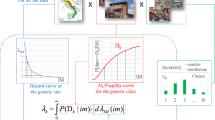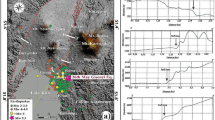Abstract
A method for the evaluation of seismic hazard in a given zone, taking into account both the spreading of macroseismic effects and seismic catalogue information, is applied. A data-bank of some 500 digitized isoseisms of earthquakes having occurred in Italy between 1542 and 1986 is used. The isoseismical maps are digitized considering for each degree of intensity the length of 24 spreading rays starting from the macroseismic epicenter or barycentre of the megaseismic area. These rays are separated from each other by the same angle, i.e. every isoseism is divided into 24 equal circular sectors. The year 1542 is taken as the beginning of the time span, since this is when the first seismic event occurred for which reliable isoseismal maps are available. The epicentral intensities considered lie between theVI andXI degrees of the Mercalli-Cancani-Sieberg scale (MCS). This digitized data-bank is analyzed to achieve, for each homogeneous seismogenetic zone that has been recognized, the mean azimuthal spreadings of effects for each degree of intensity as a function of the epicentral intensity. Once a mean propagation model is obtained for each zone, this is applied to seismic events of the same zone, the isoseismal maps of which are not available. A geographic grid is defined to cover the analyzed area, and for each cell of this grid it is then possible to count the number of felt events and their degree. These effects have been evaluated either on the basis of the isoseismal maps (when available) or on the basis of the mean propagations of the zone in which the single event occurred. Moreover, an index summarizing the seismic information was computed for each cell of the previous grid. All the events producing effects and their provenance are stored on files, allowing the main seismogenic zones influencing this cell to be identified. This methodology has been applied to central and southern Italy in an area between the latitudes 40.6 and 43.3 N. In particular, attention is focussed on the sample areas of Rome (given the historical and political importance of the city) and of the Sannio-Matese and Irpinia zone (in which some of the strongest earthquakes of the Apennine chain have occurred). Finally, in order to evaluate the maximum expected magnitude, extreme value statistics (Gumbel III-type) are applied to the Colli Albani area, which represents the seismogenic zone nearest to Rome. For the Sannio-Matese and Irpinia area, considering the more dangerous zone as a ‘unicum’, theWeibull distribution has been hypothesized to determine the mean return time for events with an intensity greater than or equal to IX.
Similar content being viewed by others
References
Baratta, M.: 1901,I terremoti d'Italia, Bocca, Turin.
Basili, A., Valensise, G.: 1986, Contributo alla caratterizzazione della sismicità dell'area Marsicano-Fucense,Proc. II Workshop Aree Sismogenetiche e Rischio Sismico in Italia (in press).
De Rossi, M. S.: 1987, I terremoti nella città di Roma.Bull. Vulcanismo Italiano,18/20, 9–21.
ENEL (Ente Nazionale Energia Elettrica): 1977,Catalogue of Italian Earthquakes from 1000 to 1975, Rome.
Favali, P., Scalera, G. C., and Smriglio, G.: 1986, Considerazioni sulle caratteristiche dei campi macrosismici interessanti l'Italia centrale (dal 1542 al 1984).Mem. Soc. Geol. It. 35, 417–424.
Gumbel, E. J.: 1958,Statistics of Extremes, Columbia University Press, New York and London.
ING (Istituto Nazionale di Geofisica):Seismic Activity in Italy (1975–1979).
ING (Istituto Nazionale di Geofisica):Macroseismic Bulletin (1980–1986).
ING (Istituto Nazionale di Geofisica):Seismic Bulletin (1980–1986).
ING (Istituto Nazionale di Geofisica): 1983a,Macroseismic Atlas, Rome.
ING (Istituto Nazionale di Geofisica): 1983b,Atlas of Isoseismal Maps from 393 to 1981, 6 vols, Rome.
ING (Istituto Nazionale di Geofisica): Catalogue of Italian earthquakes from 1450 BC to AD 1800, Rome (internal report).
Jeffreys, H.: 1948,Theory of Probability, Oxford University Press, New York.
Martinelli, G.: 1913, Terremoto Romano del 31 agosto 1909 (I centri sismici — Nota II),Boll. Soc. Sism. It. 17, 3–11.
PFG: 1981. Tectonic map of Italy 1:1500000, CNR Publ. No. 269, Rome.
PFG: 1983. Neotectonic map of Italy (6 sheets 1:500 000).Quaderni della Ricerca Scientifica, CNR114(4), Rome.
Postpischl, D. (ed.): 1985,Atlas of Isoseismal Maps of Italian Earthquakes, PFG-CNR, Bologna.
Rikitake, T.: 1976, Recurrence of great earthquakes at subduction zones,Tectonophysics 35, 335–362.
Serva, L., Blumetti, A. M., and Michetti, A. M.: 1986, Gli effetti sul terreno del terremoto del Fucino (13.1.1915); tentativo di interpretazione dell'evoluzione tettonica recente di alcune strutture,Mem. Soc. Geol. It. 35, 893–907.
Stepp, J. C.: 1973, Analysis of completeness of the earthquake sample in the Puget Sound area. Contributions to seismic zoning, NOAA TR ERL267, ESL30, Boulder, Colo.
Tacchini, P.: 1895, Terremoto di Roma del 1 novembre 1895, in M. Baratta, (ed.) Notizie sui terremoti avvenuti in Italia durante il 1895,Boll. Soc. Sism. It. 1, 203–211.
Weibull, W.: 1951, A statistical distribution function of wide application,J. Appl. Mech. 18, 293–297.
Author information
Authors and Affiliations
Rights and permissions
About this article
Cite this article
Basili, A., Favali, P., Scalera, G. et al. An attempt to evaluate seismic hazard in Central-Southern Italy. Nat Hazards 3, 31–47 (1990). https://doi.org/10.1007/BF00144972
Received:
Issue Date:
DOI: https://doi.org/10.1007/BF00144972




